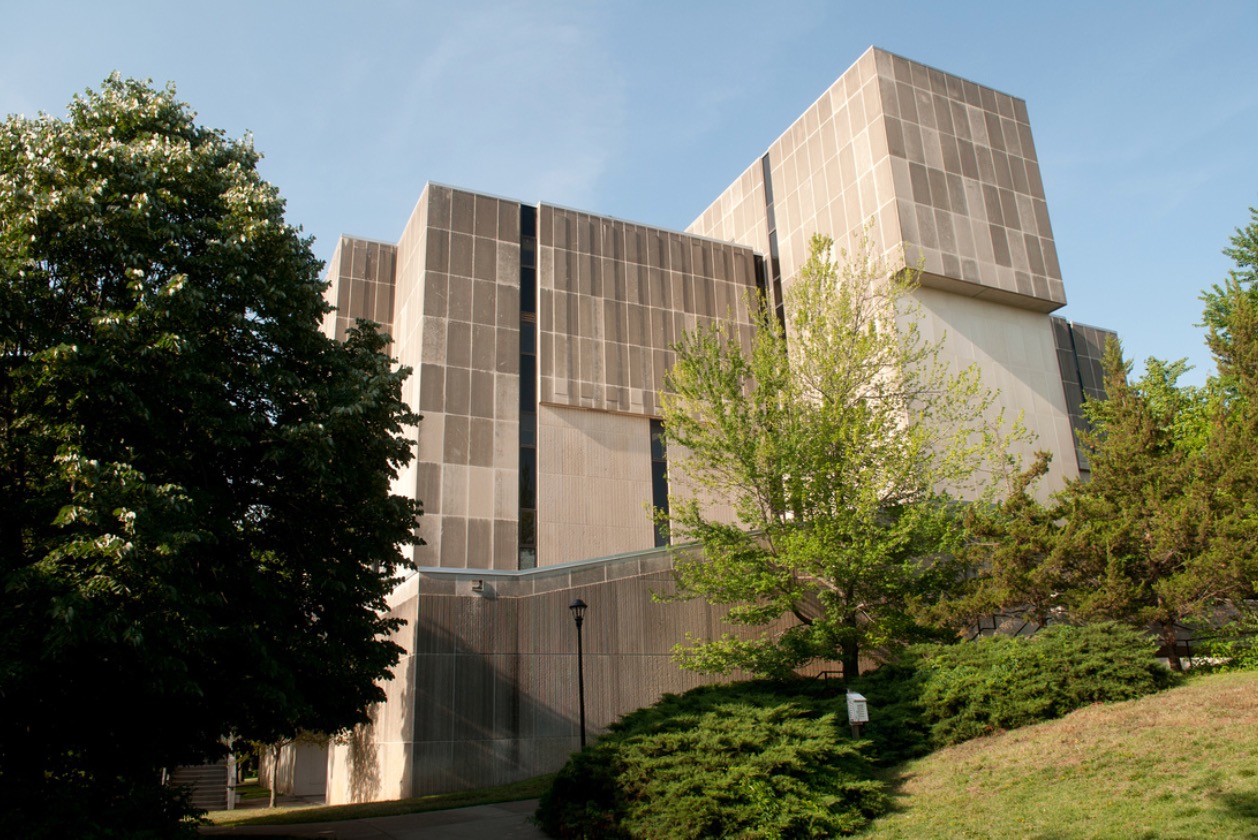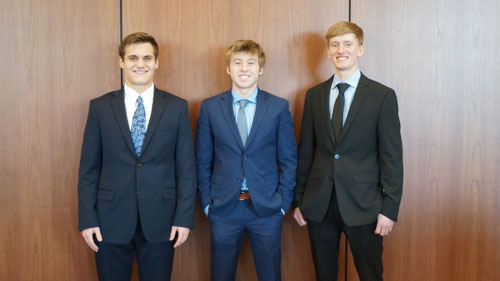03/18/20
K-State Current - March 18, 2020
K-State Current is a weekly news update for the Kansas Board of Regents to apprise the Regents on a few of the many successes and achievements made by K-State faculty, staff and students.

K-State News
New research improves understanding of nanomedicine for cancer treatment
 A new study from researchers with the Kansas State University College of Veterinary Medicine reports the current progress and limitations of using nanoparticle-based drug formulations to treat cancer.
A new study from researchers with the Kansas State University College of Veterinary Medicine reports the current progress and limitations of using nanoparticle-based drug formulations to treat cancer.
The researchers' study, "Meta-analysis of nanoparticle delivery to tumors using a physiologically based pharmacokinetic modeling and simulation approach," was recently published in the journal ACS Nano. Lead author was Yi-Hsien Cheng, a postdoctoral researcher in the lab of Zhoumeng Lin, assistant professor of anatomy and physiology and faculty member of the Institute of Computational Comparative Medicine in the College of Veterinary Medicine; Lin; and former K-State researchers Chunla He, Jim Riviere and Nancy Monteiro-Riviere. Riviere and Monteiro-Riviere are university distinguished professors emeriti of the college.
Nanoparticles — tiny particles between 1 and 100 nanometers in size — can be used to deliver medication directly to cancer cells. This method may provide an alternative to traditional chemotherapy drugs, which can kill healthy cells in addition to cancer cells.
"Nanoparticles can be engineered to have different physicochemical and biological properties, such as different shapes, sizes, charges and surface coatings, to provide a multifunctional platform for diagnosis and targeting therapy," Cheng said. "Examples include, but are not limited to, self-assembled polymeric micelles and liposomes that can be encapsulated with anticancer drugs to enhance tumor targeting and on-site drug releasing."
In the last 15 years, a large amount of research has been devoted to the design of nanomedicines with different physicochemical properties that have higher cancer therapeutic indices. Many of these nanomedicines have been shown to be effective in reducing tumor size, but very few formulations have been approved for human use.
"To improve our understanding of cancer nanomedicine, we need to know the current progress of the delivery efficiency of nanoparticles to the tumor site, and the key factors that determine nanoparticle tumor delivery efficiency," Lin said.
Lin and his co-authors used a physiologically based pharmacokinetic, or PBPK, modeling and simulation approach to analyze 200 pharmacokinetic studies, which involve 376 datasets that cover a wide range of nanomedicines.
By using the PBPK modeling and simulation approach, Lin and his team found mean and median delivery efficiencies, at the last sampling time point, of only 2.23% and 0.76% of the injected dose, respectively. The mean and median delivery efficiencies were 2.24% and 0.76% of injected dose at 24 hours, and were decreased to 1.23% and 0.35% of injected dose at 168 hours, respectively, after intravenous administration.
These results show the efficiency of nanomedicine used for cancer treatment has room for improvement. If only a small percentage of the injected nanoparticles get delivered to the tumor, they cannot work as efficiently as they were designed to be.
"These surprisingly low tumor delivery and cancer cell targeting efficiencies suggest the importance of examining key physicochemical and pharmacokinetic determinants of nanoparticle disposition within the tumor microenvironment," said Riviere, the founding director of the Institute of Computational Comparative Medicine.
"While there is great potential of nanomedicine in treating cancer and there has been some progress in the past two decades, it is important to review the current progress and identify knowledge gaps to guide future studies," said Monteiro-Riviere, the founding director of the Nanotechnology Innovation Center of Kansas State.
"It is a challenge to systemically analyze hundreds of datasets from different studies with different study designs using different nanoparticles, but PBPK modeling makes this analysis possible because it is a mechanism-based modeling approach that considers the physiology of the organism and the physicochemical and pharmacokinetic properties of the nanoparticles in the analysis," Lin said. "PBPK models also have the advantage of robust extrapolation capability, across species, exposure doses, routes and duration."
College of Education shares innovative teaching strategies with Chapman teachers
 Four College of Education faculty members traveled to Chapman in late January to provide professional learning sessions for the district's middle and high school teachers.
Four College of Education faculty members traveled to Chapman in late January to provide professional learning sessions for the district's middle and high school teachers.
Sessions for Chapman's middle and high school teachers we led by James Alberto, instructor of curriculum and instruction-science; Brad Burenheide, associate professor of curriculum and instruction-social studies; Angie Messer, instructor of curriculum and instruction; and Suzanne Porath, assistant professor of curriculum and instruction-English.
Mary Wright, Chapman Middle School principal, coordinated the sessions, which addressed various teaching strategies, engaging activities and modeling interactive learning pedagogy. The educators evaluated language used in math questioning and analyzed assessments using the depth of knowledge level rubrics. Social studies teachers focused on historical inquiry, the art of making history come to life, while English teachers worked with #BookSnaps and science teachers created a video using #FlipGrid.
Wright said the middle school teachers appreciated the opportunity to collaborate.
"The teachers enjoyed having time to implement new strategies and the help they received from K-State faculty as they created new lessons and materials for their classrooms," Wright said. "They also really appreciated working with high school math teachers because it allowed them to discuss different methods and learn new methods to better prepare the kids for high school."
Kevin Suther, Chapman High School principal, said the Chapman High School staff was excited, rejuvenated and filled with new ideas after going through training with the K-State faculty.
"It was a chance to have direct, content-specific information for all of our core teachers to learn about strategies, collaborate on future projects and bring in new approaches to education," Suther said. "I want to truly thank them for taking the time to help our staff grow."
Kansas State University takes lead in Kansas for climate change education project
 With schools across the country shuttering classes due to the coronavirus, one climate education project is moving full-speed ahead. Kansas State University will be the lead university in the state for the major national climate education initiative, Solve Climate by 2030.
With schools across the country shuttering classes due to the coronavirus, one climate education project is moving full-speed ahead. Kansas State University will be the lead university in the state for the major national climate education initiative, Solve Climate by 2030.
The nationwide, virtual teach-in focused on local solutions to climate change is set for April 7 and will feature simultaneous, university-led webinars in nearly all 50 states plus the District of Columbia, Puerto Rico and five international sites.
"For teachers scrambling to move classes online, the April 7 event provides a ready-made lesson plan to assign the webinar as homework, and then 'make climate a class' — online if needed — the next day," said Larry Erickson, adjunct faculty member in the Tim Taylor Department of Chemical Engineering and Kansas State University's contact for the virtual education project.
For more information, contact Erickson at lerick@k-state.edu, or visit solveclimateby2030.org/ or bard.edu/cep/solardominance/powerdialog/.
K-State Faculty Highlights
Veterinary medicine study develops new vaccine method for cattle disease
 Researchers at the Kansas State University College of Veterinary Medicine, in collaboration with Iowa State University, have developed a new vaccine delivery platform to produce long-lasting protection against anaplasmosis infections.
Researchers at the Kansas State University College of Veterinary Medicine, in collaboration with Iowa State University, have developed a new vaccine delivery platform to produce long-lasting protection against anaplasmosis infections.
Bovine anaplasmosis, caused by the blood-borne parasite Anaplasma marginale, is the most prevalent tick-transmitted disease of cattle worldwide and causes significant disease loss to beef producers in the United States.
"Currently, a common strategy to control anaplasmosis is to provide mineral or feed containing the antibiotic chlortetracycline to cattle on pasture," said Andrew Curtis, doctoral research assistant in the laboratory of Hans Coetzee, professor and head of the anatomy and physiology department.
"This practice has raised concerns about the potential emergence of antimicrobial resistance in bacteria that may pose a risk to human and animal health," Curtis said. "Although there is an experimental vaccine available to control anaplasmosis, it requires multiple injections and it has not been evaluated in published research studies."
The objective of the College of Veterinary Medicine study was to develop a single-dose implant vaccine platform that provides long-term immunity against anaplasmosis infections by releasing vaccine contents over an extended period.
This new single-dose vaccine, which is administered in the back of the ear, has been shown to protect against clinical anaplasmosis for up to two years and could potentially help make anaplasmosis control more accessible and convenient to livestock producers, Curtis said.
“The concept of providing cattle with a single vaccine implant that could potentially provide lifelong protection against an economically devastating disease, such as bovine anaplasmosis, could revolutionize livestock production,” Coetzee said.
Iowa State University currently holds a patent for the implant platform and the K-State/Manhattan Innovation Center is exploring a partnership with Iowa State to further develop this technology.
The first step to a commercially available product would include finding a commercial partner to seek approval from the U.S. Department of Agriculture.
In addition to Curtis and Coetzee, K-State researchers involved with the project include Miriam Martin, Brandt Skinner, Shawnee Montgomery, Tippawan Anantatat, Kathryn E. Reif, Majid Jaberi-Douraki, Emily J. Reppert and Michael Kleinhenz. Researchers from Iowa State include Sean Kelly, Balaji Narasimhan and Douglas Jones.
This project was supported in part by the Iowa Livestock Health Advisory Council and the faculty start-up funding provided by Kansas State University.
The study, "Rapid Communication: Development of a subcutaneous ear implant to deliver an anaplasmosis vaccine to dairy steers," was published in the Journal of Animal Science.
K-State Student News
K-State Sales Program hosts inaugural High School Sales Competition
 Seventeen students from six high schools across Kansas competed in the first high school sales competition hosted by the National Strategic Selling Institute on Feb. 26, at the Kansas State University College of Business Administration. Hunter Hartner, senior at Republic County High School, placed first; Cameron Ferencz, senior at Shawnee Mission Northwest High School, placed second; and Tray Zabokrtsky, senior at Washington County High School, placed third.
Seventeen students from six high schools across Kansas competed in the first high school sales competition hosted by the National Strategic Selling Institute on Feb. 26, at the Kansas State University College of Business Administration. Hunter Hartner, senior at Republic County High School, placed first; Cameron Ferencz, senior at Shawnee Mission Northwest High School, placed second; and Tray Zabokrtsky, senior at Washington County High School, placed third.
This competition was designed to be a learning experience and spark a student's interest in pursuing a career in sales. Students were provided with a role-play scenario at the beginning of the year to begin preparation for the event. For this particular sales competition, they were selling a lunch tray to a school district. The students knew the lunch tray was more expensive than what was currently being used so they had to sell them on the value of the new lunch tray, which included a focus on sustainability and the company they were representing. All students participated in the first round, then based on their performance students advanced to round two and then a final round showcasing the top three students.
"It was a great opportunity to host young talent on campus while showcasing their skills in events very similar to that of which college students participate," said Kellie Jackson, managing director of the National Strategic Selling Institute. "The current sales students that assisted in buying and judging with the event were very impressed at how well the students prepared and engaged. We would like to congratulate them again on a job well done. As one of the top sales programs in the country, we look forward to other similar events in the future to help prepare high school students for college success."
Students from the following high schools competed in the competition:
- Marmaton Valley High School
- Palco High School
- Republic County High School
- Shawnee Mission Northwest High School
- Washington County High School
- Wichita East High School
To see all the photos from the event, please visit our Facebook page.
The National Strategic Selling Institute is housed in the College of Business Administration, which has been named one of the top sales programs in the country for eight straight years by the Sales Education Foundation. In fall 2018, Kansas State became just the 19th university in the U.S. to offer a major in sales. Students can also earn a certificate in professional strategic selling, which is open to all majors at the university. The professional strategic selling program introduces students to the fundamentals of sales and through the innovative curriculum and sales labs allows students to develop the skills needed to be successful.
For more information on the National Strategic Selling Institute or its events, please contact kstatesalesprogram@k-state.edu.